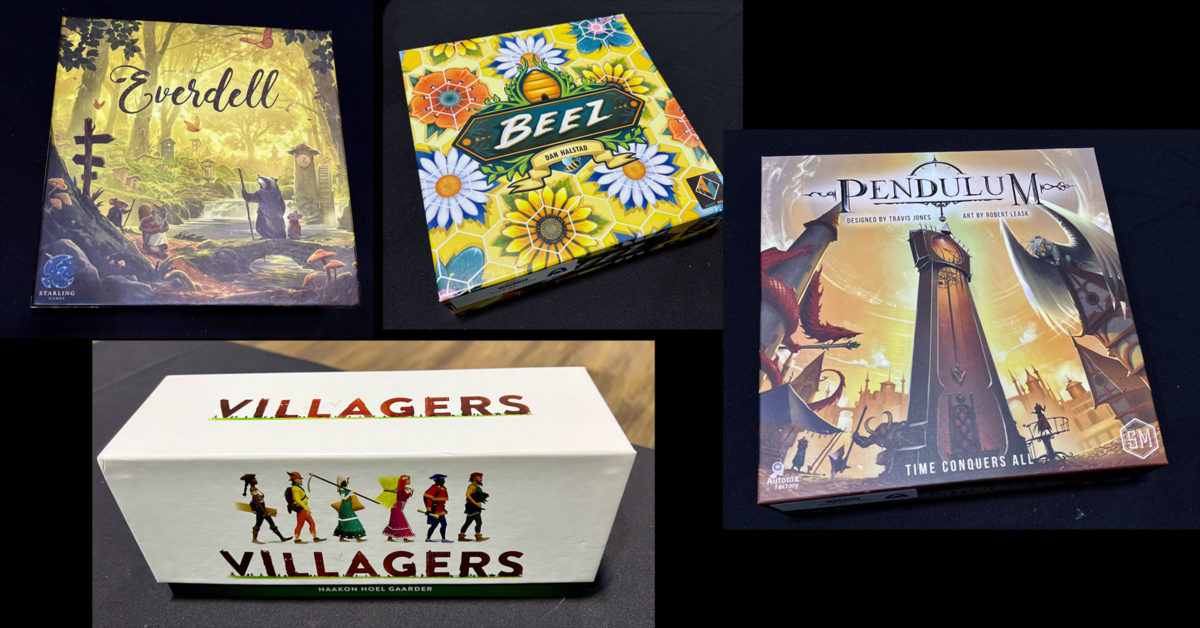See previous reports here: Day 1 | Day 2 | Day 3
The final day of Geekway is usually a Sunday morning, and usually it’s only games from the library, not play-and-win, because the organizers are busy making sure the play-and-win games have all their components in anticipation of the giveaway. But this year, owing to the semi-shortened schedule, they decided to allow play-and-win checkouts until 2 p.m., with the drawing and game pickup at 5. So, we got in a couple play-and-win games in the morning, and then a couple from the library while we waited for the convention to wrap up.Pendulum
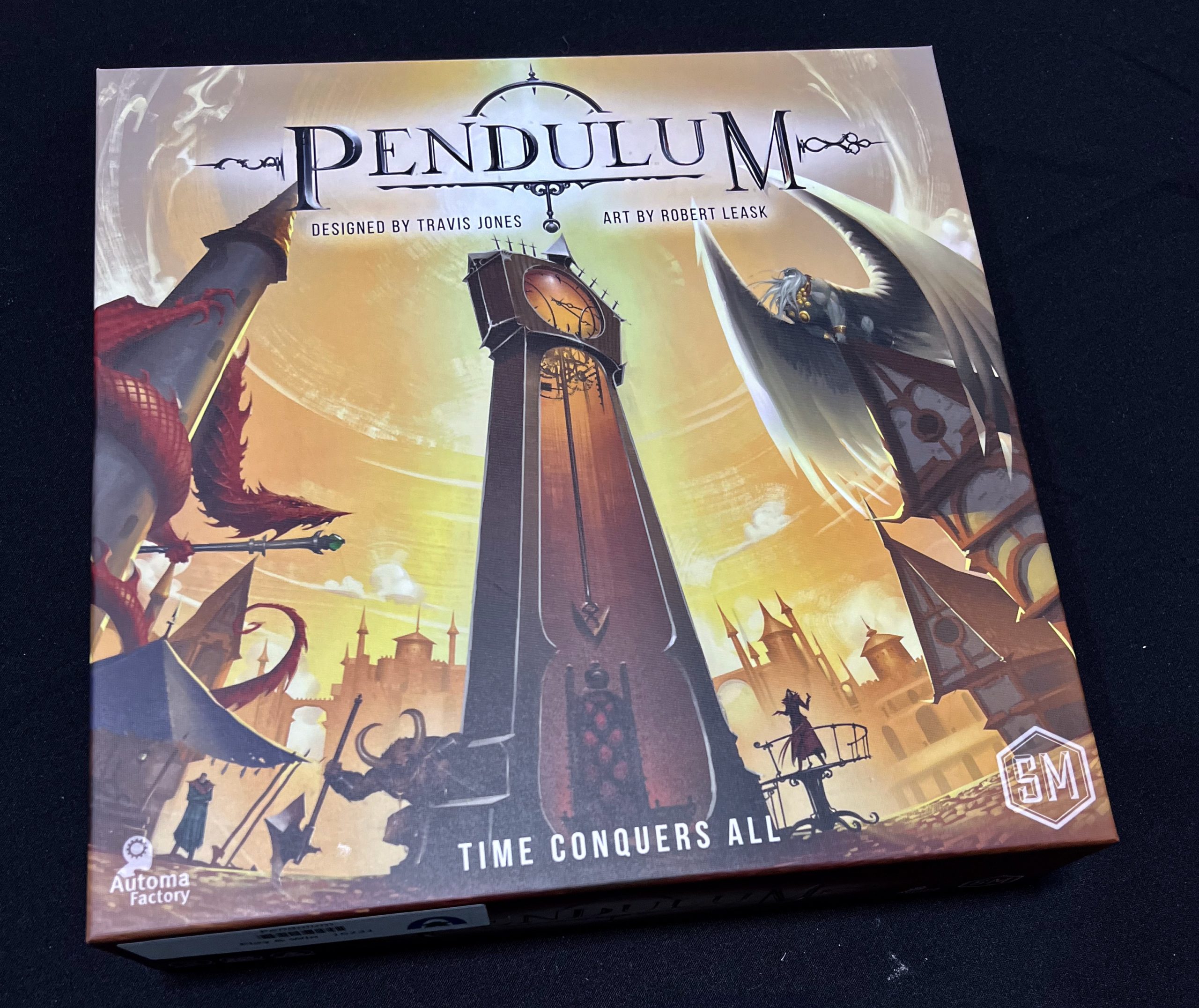 First up, as our apparently traditional heavy morning game, was Pendulum. Another one by Stonemaier games, and it was weird. Interesting though.
The conceit here is that this is a real-time game. Players aren’t taking turns, instead you’re moving workers around on a board, but the movement rules are governed by sand timers which get flipped throughout the game. Occasionally you stop and have a round that’s out of that flow, but the majority of the gameplay is supposed to be simultaneous.
There are three timers: 45 seconds, 2 mintues and 3 minutes in different areas of the board. Essentially, these “lock” those sections of the board when the sand is running. You can stage a worker in an area before the timer flips, then once it flips, take the relevant action. But even after you’ve taken the action, that worker is locked up until the timer flips again. There are a few other rules regarding how many workers can be in a space, etc. but the timers thing is really what sets this game apart.
For example, if you put a worker in the 3-minute square at the beginning of the round, the timer will flip and you can take that action. But you won’t get that worker back for 3 minutes. If you’d put the worker in the 45-second spot before the timers flipped, it would be free to move somewhere else 45 seconds later. In general, the 3-minute actions are more powerful than the 2-minute actions, which are more powerful than the 45-second actions. But they’re all different and what you need at any given time may vary.
We didn’t do any of that.
The game includes instructions for playing through a round un-timed, and recommends you take at least the first round that way, if not your first game. So that’s what we did. There’s a card showing the order of flipping the timers, which you still do, but you take as long as you want in between flipping them. The card is structured so that the timers all still flip about when they normally would, in relation to each other, so you get a sense of what a real game would be, without the time pressure.
At the end of each round — after the three-minute timer has flipped three times (including to start the round) — there’s a “council” phase, where privilege (Pendulum’s way of settling disputes when two players want to do the same thing at the same time but can’t) is determined for the next round and rewards are claimed. There are four rounds.
It’s an asymmetric game in that each player is playing a different character. There are three types of victory points, and to win you need to earn a certain number of each type (plus a “legendary achievement”, which you need to earn once at any time during the game). But each player needs to earn a different amount of the different types — one player needs an equal amount of each, other players need more of one kind or another. This is balanced by the amounts of income of different types the player earns for different actions, as well as the special abilities (in the form of cards played any time during the round, and potentially refreshed to play again).
First up, as our apparently traditional heavy morning game, was Pendulum. Another one by Stonemaier games, and it was weird. Interesting though.
The conceit here is that this is a real-time game. Players aren’t taking turns, instead you’re moving workers around on a board, but the movement rules are governed by sand timers which get flipped throughout the game. Occasionally you stop and have a round that’s out of that flow, but the majority of the gameplay is supposed to be simultaneous.
There are three timers: 45 seconds, 2 mintues and 3 minutes in different areas of the board. Essentially, these “lock” those sections of the board when the sand is running. You can stage a worker in an area before the timer flips, then once it flips, take the relevant action. But even after you’ve taken the action, that worker is locked up until the timer flips again. There are a few other rules regarding how many workers can be in a space, etc. but the timers thing is really what sets this game apart.
For example, if you put a worker in the 3-minute square at the beginning of the round, the timer will flip and you can take that action. But you won’t get that worker back for 3 minutes. If you’d put the worker in the 45-second spot before the timers flipped, it would be free to move somewhere else 45 seconds later. In general, the 3-minute actions are more powerful than the 2-minute actions, which are more powerful than the 45-second actions. But they’re all different and what you need at any given time may vary.
We didn’t do any of that.
The game includes instructions for playing through a round un-timed, and recommends you take at least the first round that way, if not your first game. So that’s what we did. There’s a card showing the order of flipping the timers, which you still do, but you take as long as you want in between flipping them. The card is structured so that the timers all still flip about when they normally would, in relation to each other, so you get a sense of what a real game would be, without the time pressure.
At the end of each round — after the three-minute timer has flipped three times (including to start the round) — there’s a “council” phase, where privilege (Pendulum’s way of settling disputes when two players want to do the same thing at the same time but can’t) is determined for the next round and rewards are claimed. There are four rounds.
It’s an asymmetric game in that each player is playing a different character. There are three types of victory points, and to win you need to earn a certain number of each type (plus a “legendary achievement”, which you need to earn once at any time during the game). But each player needs to earn a different amount of the different types — one player needs an equal amount of each, other players need more of one kind or another. This is balanced by the amounts of income of different types the player earns for different actions, as well as the special abilities (in the form of cards played any time during the round, and potentially refreshed to play again).
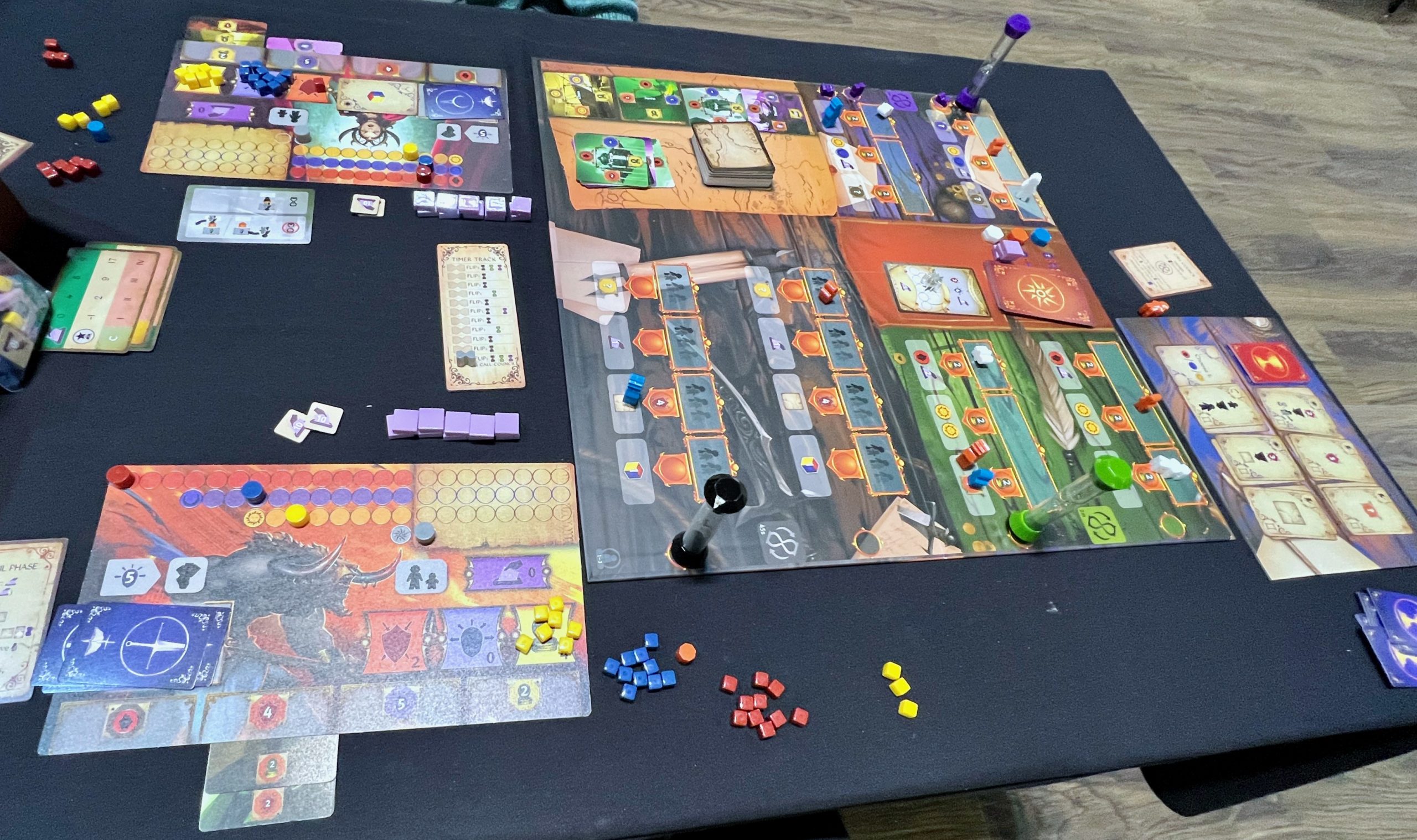 If you think that’s a lot…well, it’s a lot. It makes more sense once you’re doing it, but at no point during the first game did I feel like I had a handle on an overall strategy or how I was doing. There’s just a lot happening, and we weren’t even playing a timed game.
The components are just fine. Plastic colored cubes in different colors, tiles for council votes, workers in two sizes, player and victory point markers. Nothing outstanding. The three sand timers are in colors to match their parts of the board.
The art can be confusing at times. Moving the resource cubes and victory-point markers around on and off the player board can be clumsy, which would be a pretty big hindrance in a timed game.
I get what the fuss is — the idea of simultaneous, real-time play is neat. I’m glad I got to try it.
If you think that’s a lot…well, it’s a lot. It makes more sense once you’re doing it, but at no point during the first game did I feel like I had a handle on an overall strategy or how I was doing. There’s just a lot happening, and we weren’t even playing a timed game.
The components are just fine. Plastic colored cubes in different colors, tiles for council votes, workers in two sizes, player and victory point markers. Nothing outstanding. The three sand timers are in colors to match their parts of the board.
The art can be confusing at times. Moving the resource cubes and victory-point markers around on and off the player board can be clumsy, which would be a pretty big hindrance in a timed game.
I get what the fuss is — the idea of simultaneous, real-time play is neat. I’m glad I got to try it.
Beez
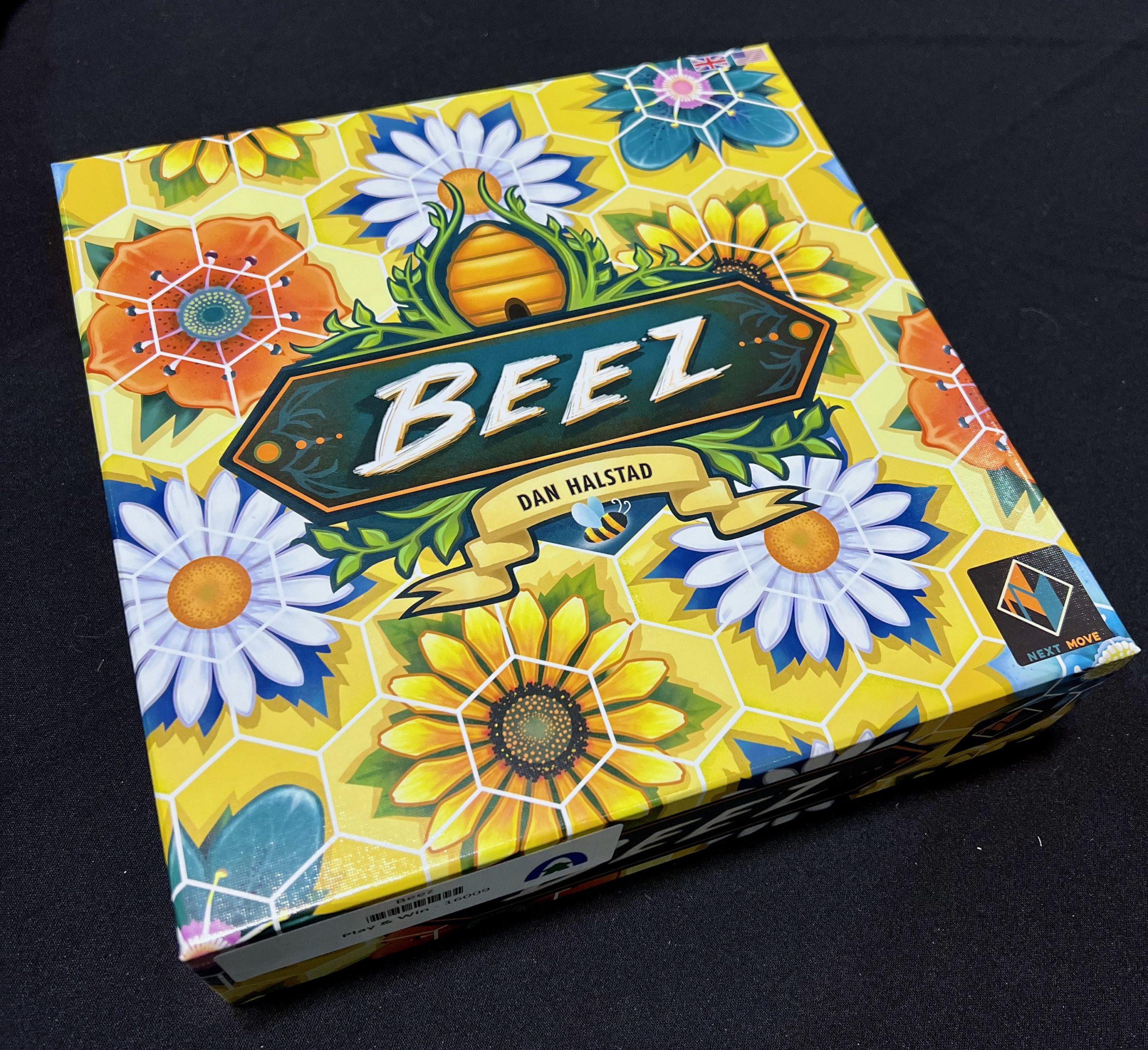 Beez was a good followup. It was our last play-and-win game.
In Beez, you lay out a hexagonal field of flowers with different varieties of nectar, and you are a bee planning a route to collect that nectar and place it in your hive. There are a few community goals, and a couple private goals. These are related to how much and what type of nectar you collect, as well as how you choose to arrange them in your hive.
In Beez, your bee moves according to a particular set of rules — you can never move straight ahead. Your bee is sitting on a hexagonal hive, the same shape as the spaces on the board. You can never move directly forward. You can move either one or five hexes toward one of the front angled directions. You can move either two or four hexes toward one of the rear angled directions. Or you can move three hexes directly backward. In all cases, you choose your move, then — importantly — turn your bee to face that direction and move that number of spaces.
If the space you landed on is adjacent to some nectar, you can pick it up and put it on your board (there’s a bonus for landing in the center of a flower with some nectar, as well). You can only put it into a spot in your hive that matches the length of move you just took. (This relates to the “how you arrange them in your hive” goals, so you can’t just put them anywhere).
Beez was a good followup. It was our last play-and-win game.
In Beez, you lay out a hexagonal field of flowers with different varieties of nectar, and you are a bee planning a route to collect that nectar and place it in your hive. There are a few community goals, and a couple private goals. These are related to how much and what type of nectar you collect, as well as how you choose to arrange them in your hive.
In Beez, your bee moves according to a particular set of rules — you can never move straight ahead. Your bee is sitting on a hexagonal hive, the same shape as the spaces on the board. You can never move directly forward. You can move either one or five hexes toward one of the front angled directions. You can move either two or four hexes toward one of the rear angled directions. Or you can move three hexes directly backward. In all cases, you choose your move, then — importantly — turn your bee to face that direction and move that number of spaces.
If the space you landed on is adjacent to some nectar, you can pick it up and put it on your board (there’s a bonus for landing in the center of a flower with some nectar, as well). You can only put it into a spot in your hive that matches the length of move you just took. (This relates to the “how you arrange them in your hive” goals, so you can’t just put them anywhere).
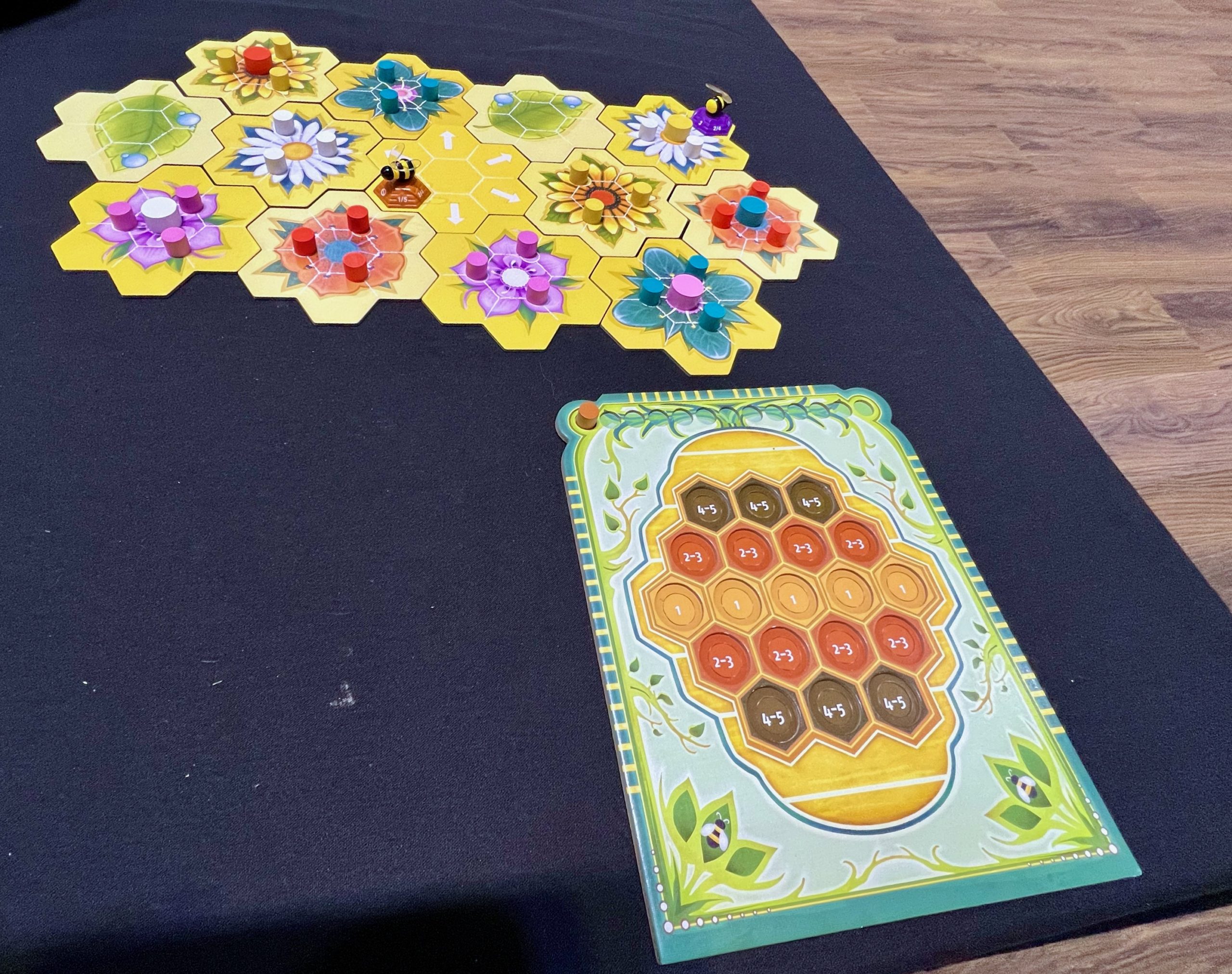 The components of this game are a delight, especially the adorable bees. The color palette is interesting and appropriate as well. The beehive player boards have indentations for the nectar pieces, to ensure they stay where you put them.
This one is easy to pick up, and planning out a route is, at least for my brain, more challenging than I expected. It does seem that, given the arrangement of the nectar is mostly knowncen and the movement capabilities are definitely known, you should be able to plan an optimal route. But the goal cards and arrangement of the flower colors will be different so that could be enough randomness. Additionally you aren’t allowed to land on another bee, so the more players in the game, the more likely that would come into play too.
The components of this game are a delight, especially the adorable bees. The color palette is interesting and appropriate as well. The beehive player boards have indentations for the nectar pieces, to ensure they stay where you put them.
This one is easy to pick up, and planning out a route is, at least for my brain, more challenging than I expected. It does seem that, given the arrangement of the nectar is mostly knowncen and the movement capabilities are definitely known, you should be able to plan an optimal route. But the goal cards and arrangement of the flower colors will be different so that could be enough randomness. Additionally you aren’t allowed to land on another bee, so the more players in the game, the more likely that would come into play too.
Everdell
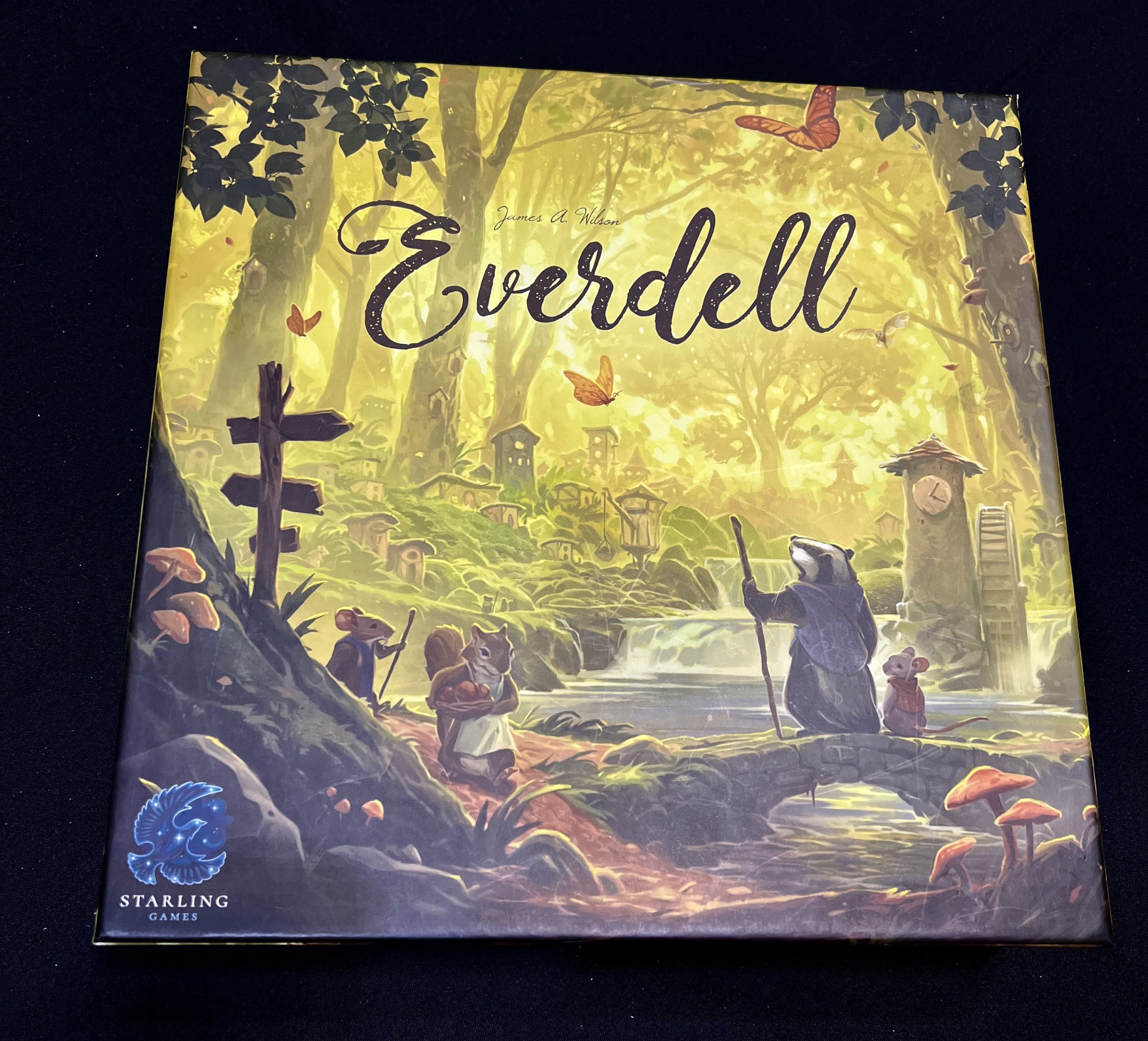 I got Everdell out of the library to play because I recognized the name, though I couldn’t tell you from where. I didn’t realize it’s ranked 28 overall on Board Game Geek. I’ve only played a couple of games ranked higher.
Everdell is a fantasy worker-placement tableau-building game where you’re building a city in the forest over a year’s worth of seasons. Each season you send out your workers to gather resources or give you abilities or victory points and play cards to build buildings or bring residents to your city.
There’s a small bit of engine-building, as some cards let you build/destroy/modify other cards in interesting ways. Once you’ve deployed all your workers and spent all your resources building cards, you “prepare for the next season” by recalling all your workers, gaining a few more, and another action depending on the season.
One interesting thing, similar to Tapestry, is that players’ progress throughout the game isn’t synced in any way — one player can prepare for the next season while another player is still playing in the previous one.
I got Everdell out of the library to play because I recognized the name, though I couldn’t tell you from where. I didn’t realize it’s ranked 28 overall on Board Game Geek. I’ve only played a couple of games ranked higher.
Everdell is a fantasy worker-placement tableau-building game where you’re building a city in the forest over a year’s worth of seasons. Each season you send out your workers to gather resources or give you abilities or victory points and play cards to build buildings or bring residents to your city.
There’s a small bit of engine-building, as some cards let you build/destroy/modify other cards in interesting ways. Once you’ve deployed all your workers and spent all your resources building cards, you “prepare for the next season” by recalling all your workers, gaining a few more, and another action depending on the season.
One interesting thing, similar to Tapestry, is that players’ progress throughout the game isn’t synced in any way — one player can prepare for the next season while another player is still playing in the previous one.
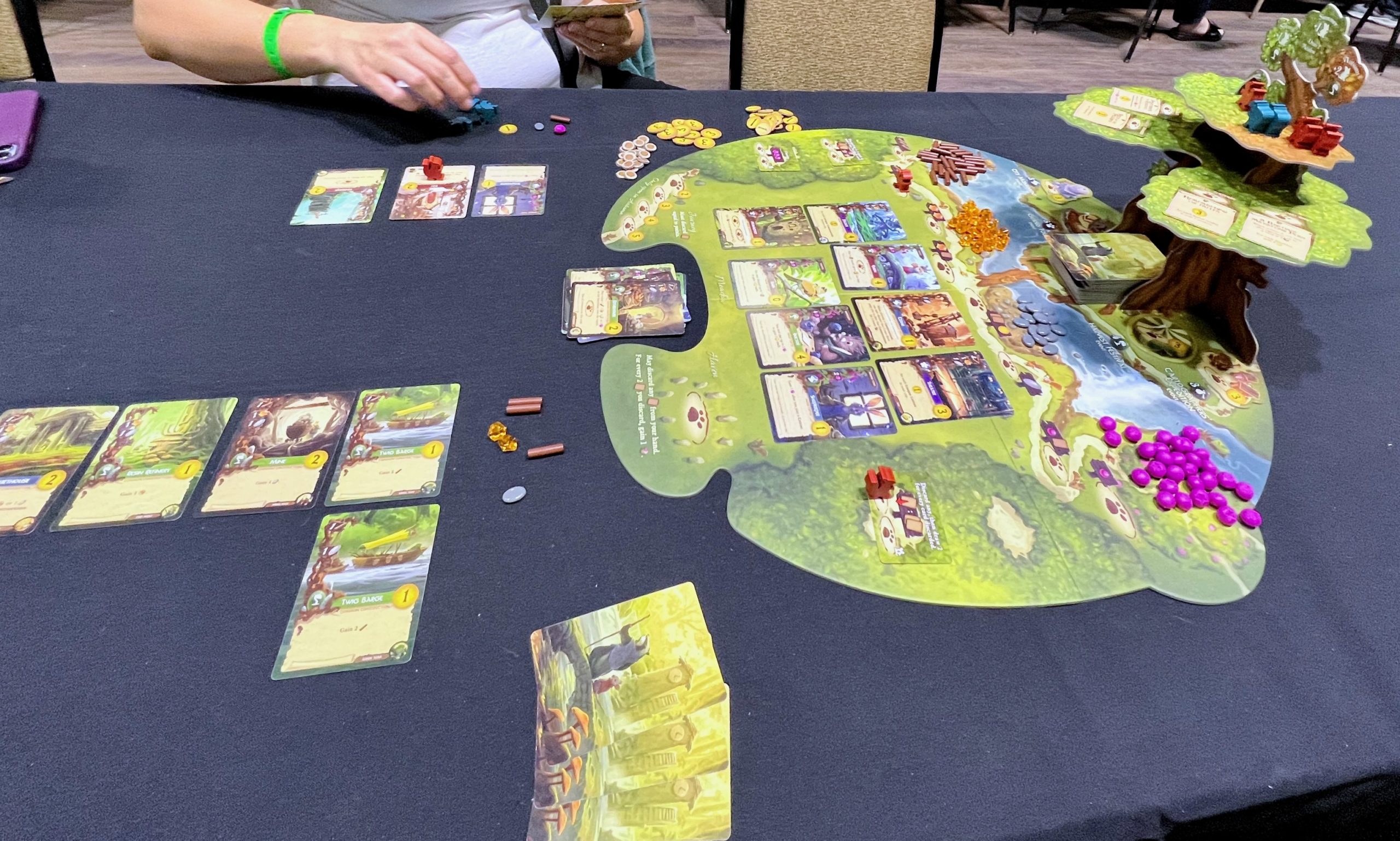 This one is just lovely to look at. The board and art are nice. There’s a giant 3D tree centerpiece that is (ok, minimally) functional. The worker tokens are animal shapes. The resource tokens are nice — the wood aren’t too interesting, but the stones are pleasingly smooth, the amber is very gemmy and the berries are bright pink and some kind of rubbery plastic that was unexpected. The card art, text and mechanics are interesting.
All in all, a very nice game.
This one is just lovely to look at. The board and art are nice. There’s a giant 3D tree centerpiece that is (ok, minimally) functional. The worker tokens are animal shapes. The resource tokens are nice — the wood aren’t too interesting, but the stones are pleasingly smooth, the amber is very gemmy and the berries are bright pink and some kind of rubbery plastic that was unexpected. The card art, text and mechanics are interesting.
All in all, a very nice game.
Villagers
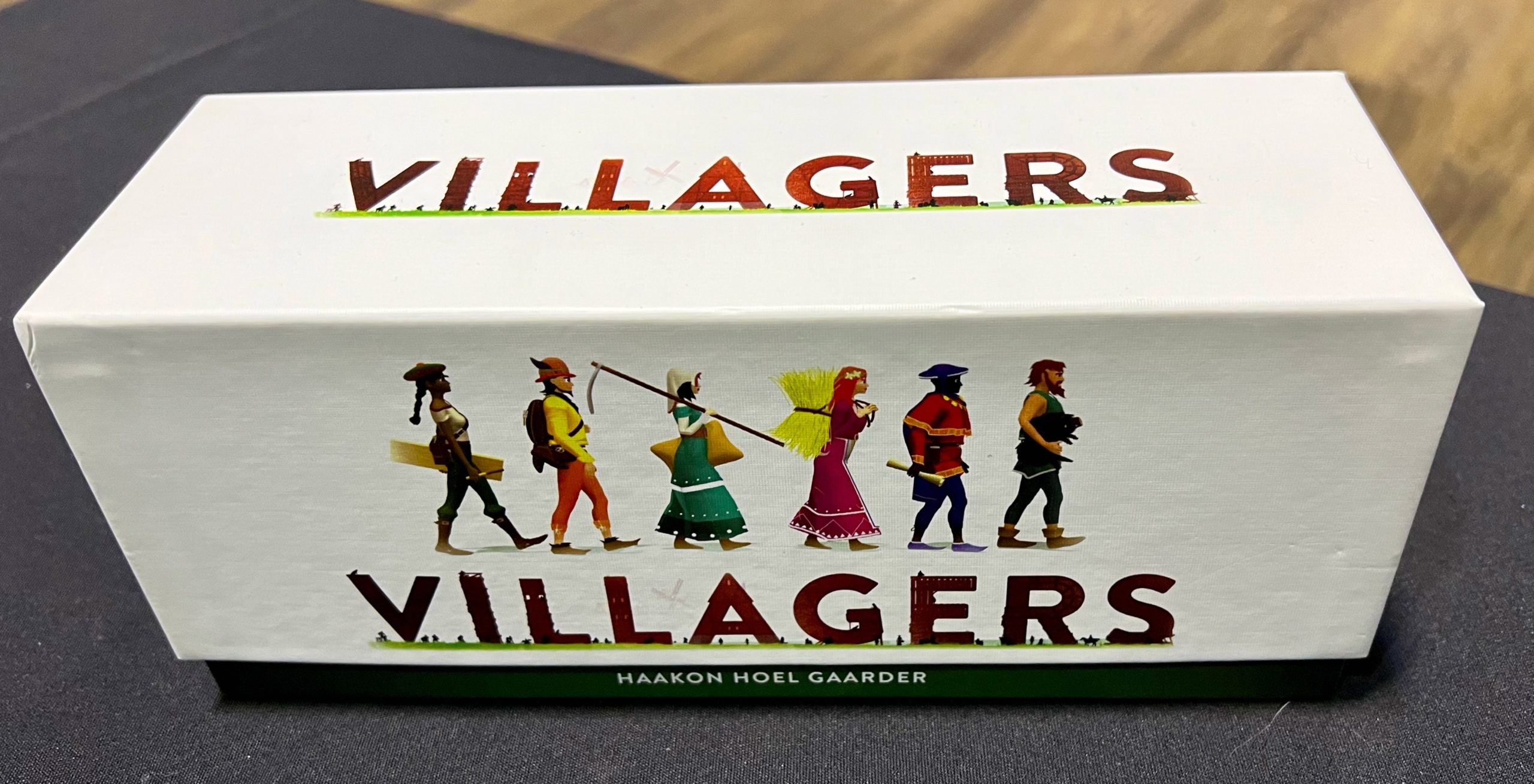 And the final game of Geekway 2021, Villagers.
Villagers is a card-drafting set-collection game where you’re playing the founder of a village and inviting travelers from the road to join your village. You’re hoping to invite villagers whose skills complement each other.
There’s a drafting round where players choose from a set of face up cards (representing travelers on the road) or drawing blindly from the face-down ones. Then there’s a round where you play cards into your village.
The cards you play might need unlocking (for example a vintner needs to be unlocked by a cooper, because a vintner would need barrels). How this works depends whether you or an opponent (or not) has the unlocking card in their village. And some cards just require a prerequisite villager to already be in your village (for example the vintner needs a graper). There are resource chains you can build up, and the more you build them up the more points they’re worth.
The number of cards you can draft and play in a round is also governed by the villagers you have, so it can be a balance between getting points and increasing your capabilities. There are a couple scoring rounds once a certain number of cards have been drafted. And that’s about it.
The art style here is nice. A bit minimalistic, but it appealed to me. The groups and production chains and locked/locking cards generally make sense. There’s a nice variety of cards and scoring opportunities as well. I enjoyed this one.
Read Day 1 | Day 2 | Day 3 | Wrapup
And the final game of Geekway 2021, Villagers.
Villagers is a card-drafting set-collection game where you’re playing the founder of a village and inviting travelers from the road to join your village. You’re hoping to invite villagers whose skills complement each other.
There’s a drafting round where players choose from a set of face up cards (representing travelers on the road) or drawing blindly from the face-down ones. Then there’s a round where you play cards into your village.
The cards you play might need unlocking (for example a vintner needs to be unlocked by a cooper, because a vintner would need barrels). How this works depends whether you or an opponent (or not) has the unlocking card in their village. And some cards just require a prerequisite villager to already be in your village (for example the vintner needs a graper). There are resource chains you can build up, and the more you build them up the more points they’re worth.
The number of cards you can draft and play in a round is also governed by the villagers you have, so it can be a balance between getting points and increasing your capabilities. There are a couple scoring rounds once a certain number of cards have been drafted. And that’s about it.
The art style here is nice. A bit minimalistic, but it appealed to me. The groups and production chains and locked/locking cards generally make sense. There’s a nice variety of cards and scoring opportunities as well. I enjoyed this one.
Read Day 1 | Day 2 | Day 3 | Wrapup 